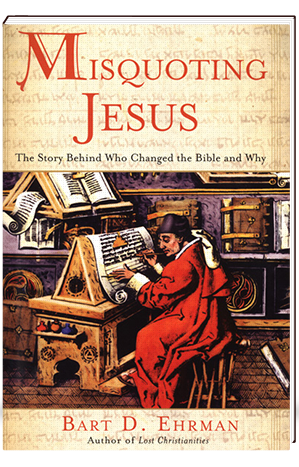
Misquoting Jesus: the Story behind Who Changed the Bible And Why
By Bart D. Ehrman
Publisher: HarperOne
Publication Date: November 1, 2005
Language: English
ISBN-10: 0060738170
Format: Hardcover, 256pp
Dimensions: 6 x 0.89 x 9 inches
Affiliate Disclaimer: We may earn commissions on products you purchase through this page at no additional cost to you. Thank you for supporting our site!
FROM LIBRARY JOURNAL
“The Bible”- its use in the singular can gloss over the fact that we do not have access to the original text, but only to manuscripts of a relatively late provenance produced at different times and places and containing among them thousands of variant wordings. An accomplished scholar of early Christianity, Ehrman (religious studies, Univ. of North Carolina, Chapel Hill) ventures out of the ivory tower in this accessible lay introduction to New Testament textual criticism. He sketches the development of New Testament literature, the gradual accumulation of errors therein through the accidental or intentional revisions of copyists, and attempts (beginning with Erasmus in the 16th century) to reconstruct the original text. Since mainstream study editions of the Bible have long drawn attention to the existence of alternate readings, the reasonably well-informed reader will not find much revolutionary analysis here. But Ehrman convincingly argues that even some generally received passages are late additions, which is particularly interesting in the case of those verses with import for doctrinal issues such as women’s ordination or the Atonement. Recommended for all public libraries. Charles Seymour, Mabee Learning Resources Ctr., Wayland Baptist Univ., Plainview, TX Copyright 2005 Reed Business Information.
FROM BOOKLIST
The popular perception of the Bible as a divinely perfect book receives scant support from Ehrman, who sees in Holy Writ ample evidence of human fallibility and ecclesiastical politics. Though himself schooled in evangelical literalism, Ehrman has come to regard his earlier faith in the inerrant inspiration of the Bible as misguided, given that the original texts have disappeared and that the extant texts available do not agree with one another. Most of the textual discrepancies, Ehrman acknowledges, matter little, but some do profoundly affect religious doctrine. To assess how ignorant or theologically manipulative scribes may have changed the biblical text, modern scholars have developed procedures for comparing diverging texts. And in language accessible to nonspecialists, Ehrman explains these procedures and their results. He further explains why textual criticism has frequently sparked intense controversy, especially among scripture-alone Protestants. In discounting not only the authenticity of existing manuscripts but also the inspiration of the original writers, Ehrman will deeply divide his readers. Although he addresses a popular audience, he undercuts the very religious attitudes that have made the Bible a popular book. Still, this is a useful overview for biblical history collections. Bryce Christensen Copyright © American Library Association. All rights reserved
